 By Bob Currie, Recreational Boating Safety Specialist
By Bob Currie, Recreational Boating Safety Specialist
U. S. Coast Guard Auxiliary Station Galveston Flotilla
When you hear the word “fender,” what comes to mind? You may get an image in your mind of that part of your car or truck that covers the wheels, or if you are a musician you might think about the brand name for guitars and amps. But if you are a mariner, then you should think about those air-filled cylindrical or spherical devices that keep you from scraping up your boat when it is docked or rafted alongside another boat. This was all brought to mind when someone showed a picture of a boat on Facebook. The boat had obviously slipped its mooring during the heavy winds we had the night before.
Fender Types
There are two basic types of fenders: cylindrical and spherical (often called round fenders or buoy fenders). There are several types of special fenders as well. Here are some examples:
Cylinder Fender, Tab Style:
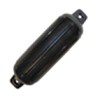 The cylindrical fenders with tabs on each end are the most common type seen. The tabs have reinforced holes for either attaching a line on one end or for running a line through both holes. As with all the fender models, air can be added to the fender if necessary through a valve located on one end.
The cylindrical fenders with tabs on each end are the most common type seen. The tabs have reinforced holes for either attaching a line on one end or for running a line through both holes. As with all the fender models, air can be added to the fender if necessary through a valve located on one end.
Cylinder Fender, Hole Through the Middle:
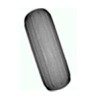 This type of fender is more expensive than the tab style and has a hole through the middle. The advantage is that with the tab style fender the line can chafe when the fender is deployed horizontally, but when the line runs through the middle of the fender there is no way for the line to become chafed.
This type of fender is more expensive than the tab style and has a hole through the middle. The advantage is that with the tab style fender the line can chafe when the fender is deployed horizontally, but when the line runs through the middle of the fender there is no way for the line to become chafed.
Buoy Fender:
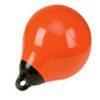 The buoy fender is particularly useful on larger boats and is often placed at the bow and stern. They come in many different sizes, such as 10”, 12”, 15” and 18” diameters. They have other uses besides as fenders. The downside is that they require more locker space when stored.
The buoy fender is particularly useful on larger boats and is often placed at the bow and stern. They come in many different sizes, such as 10”, 12”, 15” and 18” diameters. They have other uses besides as fenders. The downside is that they require more locker space when stored.
Low Freeboard Type Fender:
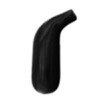 This type of fender is designed to meet the special needs of fishing boats and ski boats with low freeboard. Such boats often do not match up to the dock boards very well and tend to slip under the boards at low tide. This type of fender is shaped to protect gunwales and rub rails when the gunwale is low in relation to the dock boards.
This type of fender is designed to meet the special needs of fishing boats and ski boats with low freeboard. Such boats often do not match up to the dock boards very well and tend to slip under the boards at low tide. This type of fender is shaped to protect gunwales and rub rails when the gunwale is low in relation to the dock boards.
Pontoon Fender:
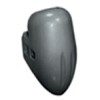 This type of fender fits snugly between the pontoon and the deck of the boat. A ridge molded into the fender hooks underneath the deck to help secure it in place. This is a permanent mount fender. Normally when you see someone running their boat with the fenders deployed you label them as an inexperienced boater who is a potential risk to experienced boaters. If you don’t know enough to pull your fenders in when you leave the dock, what else about boating do you not know?
This type of fender fits snugly between the pontoon and the deck of the boat. A ridge molded into the fender hooks underneath the deck to help secure it in place. This is a permanent mount fender. Normally when you see someone running their boat with the fenders deployed you label them as an inexperienced boater who is a potential risk to experienced boaters. If you don’t know enough to pull your fenders in when you leave the dock, what else about boating do you not know?
Dock Fender:
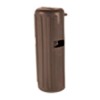 This is my favorite type of fender. It is found permanently attached to docks at marinas and bait camps, and you don’t need to deploy your own fenders to tie up to the dock when there are enough strategically placed dock fenders. Fenders take up precious locker space on small fishing boats like mine. The less I must carry the better I like it.
This is my favorite type of fender. It is found permanently attached to docks at marinas and bait camps, and you don’t need to deploy your own fenders to tie up to the dock when there are enough strategically placed dock fenders. Fenders take up precious locker space on small fishing boats like mine. The less I must carry the better I like it.
Size Matters
It is generally better to have a couple of large fenders than a line of small fenders. Fenders are filled with air, but they are not under pressure. When wave action compresses them, the air inside offers resistance and in most cases the fender will only compress to about half its original shape. Smaller fenders allow the boat to come in contact with the dock or another boat more easily than large fenders. Just be careful when stepping aboard when the larger fenders put more space between your boat and the dock. If your fenders seem to be easy to compress, you might want to add more air to them. Use a ball inflation valve and small hand pump to add air, but don’t overfill them. You don’t want any pressure in the fender; you just want it to be full of air.
Deploying Fenders
Always deploy the fenders from the boat- not the dock. This allows the fenders to follow the hull in tidal conditions and to be adjusted from the deck. In the case of permanent dock fenders, these fenders are found where boats moor temporarily to take on such things as bait, ice, or fuel. If you are going to moor for any length of time, then you need a different fender arrangement such as a fender board and fender combination. More about this arrangement below. When coming into the dock, deploy your fenders before you get to the dock. It is often useful to have an extra fender to use as a walking fender; that is, someone has an extra fender with its line in hand and can walk along the gunwale to deploy it to prevent your gunwale from contacting the dock. Never use your hand or foot to fend the boat off the dock or another boat. That is really why a lot of pirates had one leg(arrr!). Use the walking fender or a boat hook to protect your gunwale instead. Don’t forget to stow fenders away when not in use so they don’t become a tripping hazard!
Use the Right Knot
When attaching fenders over a handrail, use the slippery clove hitch because it is easy to tie, quick to release, and holds well. Some people have fender cleats designed to quickly attach and detach your fender lines. I have some fender cleats on my boat which only require you to wind the fender line around it instead of having to tie a knot. The downside to such an arrangement is that it limits fender placement. I also use the grab rail on my center console to attach a fender line.
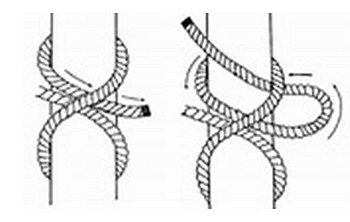
The drawing on the left is a standard clove hitch, and it works well for securing fender lines. The drawing on the right shows a slip knot added to the clove hitch, and that is what makes it slippery. The loop is used for other knots to make them easy to untie.
Fender Board
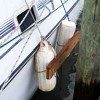 If you are going to tie your boat up to a dock for an extended period of time, you may consider using a fender board with a couple of fenders. The fender board allows the boat to moor against a piling rather than a dock board. A fender board is simply a sturdy board with a couple of fenders attached to it. The board rides against the piling, while the fenders ride against your boat. While you can deploy a single fender placed horizontally to ride against the piling, a fender board is much better protection.
If you are going to tie your boat up to a dock for an extended period of time, you may consider using a fender board with a couple of fenders. The fender board allows the boat to moor against a piling rather than a dock board. A fender board is simply a sturdy board with a couple of fenders attached to it. The board rides against the piling, while the fenders ride against your boat. While you can deploy a single fender placed horizontally to ride against the piling, a fender board is much better protection.
Rafting
This isn’t about Huckleberry Finn-type rafting. Rafting is the act of mooring two boats together. This is often done out in the open water, but it is also a method of docking more than one boat to the same space on the dock such as in this drawing. If you travel the Seven Seas in your large pleasure craft, when you get to port you may find that the captain of the port will assign you to raft against another boat. A fender board serves quite well for rafting also. Note that the drawing with the fender board shows the use of four docking lines instead of just the bow and stern lines. Such an arrangement provides extra security in case a line breaks. The two extra lines are called the bow spring line and the stern spring line.

Summary
Boaters who don’t want their boats all dinged up from contact with the pier or dock must fend for themselves. Don’t skimp when it comes to outfitting your boat with fenders and lines. If you normally need only two fenders, then have a third fender available to use as a walking fender when docking in rough water or to a rough dock or pier.
Note: If you find a boat floating free in the marina and don’t know to which slip it belongs, at least in Texas you can go to the Texas Parks and Wildlife Department TORA (Texas Open Records Act) site and find the owner’s name using the boat number lookup function: TORA: Inquiry (state.tx.us)
[BC: Dec-19-2023]

 Posted in
Posted in 
























